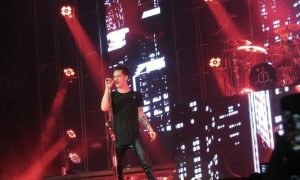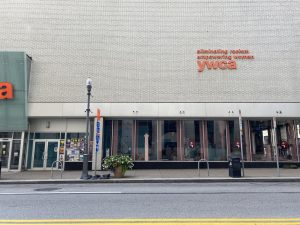Zack Snyder’s Justice League
March 24, 2021
4 Globes out of 5
When I was younger, my parents bought me a Super Friends comic book. This was my formal introduction to the Justice League, a superhero team that I would end up reading the escapades of for, at least up to this point, my entire life. The adventures of the Super Friends were lighthearted, aimed at children, but the characterization of the heroes was definite.
Zack Snyder is not interested in telling the Super Friends version of these characters. Snyder views superheroes as mythical creatures, and by proxy, he views his story as a modern-day Greek epic. He understands that the Marvel Cinematic Universe has defined the formula for the Saturday morning cartoon superhero movie and has no interest in trying to replicate that.
Snyder’s vision, however, is part of the reason that the original cut of “Justice League” was so terrible. Hoping to emulate the style and success of the Avengers movies, Warner Brothers fired Snyder and hired Joss Whedon, the director of the first two Avengers movies, to rewrite the script and film reshoots.
What resulted was two movies with completely different tones smashed together, filled with bad green screens, awful jokes, and actors with varying degrees of interest in completing the reshoots. It’s a bit like the Starz reality show “The Chair” (produced by Point Park), which had two different directors make films based on the same premise. Only then it’s as if Warner Brothers cut those two movies together and pretended like it was the original director’s vision for the movie.
After three and a half years of fan campaigning, Warner Bros has finally released Zack Snyder’s original vision for Justice League. The four-hour long film cost an estimated $70 million to complete, with costs going towards completing visual effects and shooting additional material. The film is not available in theaters and can only be streamed on HBO Max.
I went into this with low expectations. Not only did I hate the original cut of “Justice League,” but I also wasn’t a huge fan of Snyder’s previous works within the DC universe, most notably 2016’s “Batman v Superman: Dawn of Justice.” Add to that a four-hour runtime, and I would be lying if I said I wasn’t expecting to enjoy it.
But I was wrong. Zack Snyder’s “Justice League” is a triumph of what a superhero movie can be. It is definitive proof that superhero movies are cinema. It is a vindication for the fans who spent years campaigning for the release of this movie. It is a modern-day Greek epic juxtaposing the godlike powers of metahumans against the mortal world of man. But most of all: it is a good movie.
Make no mistake; this is a completely different movie than the original. Entire characters had their arcs stripped down, reduced to nothing more than side characters. Most notable of all this is the character of Cyborg.
Cyborg’s actor, Ray Fisher, has had a very public feud with Warner Bros about his treatment on the set of the “Justice League” reshoots. I now completely understand his frustrations. His role in this film was cut from being the main character to being the least important member of the team. Fisher’s performance here is incredible, and the sheer range that he is able to bring to a mostly motion-captured character is astounding.
Every single other member of the Justice League is also well portrayed here. Gal Gadot proves that she is the definitive Wonder Woman and that the quality of her performance is necessitated by the quality of the script and direction that she is given. Ezra Miller is an absolute delight as The Flash and another standout star of the film. Henry Cavill’s Superman finally becomes the definitive symbol of hope that Snyder set out for him to become in the three-film arc that began all the way back in 2013’s “Man of Steel.” Jason Momoa as Aquaman is Jason Momoa as Aquaman—it’s been proven to work, and it continues to work here.
But the standout member of the team, in my opinion, was Ben Affleck’s Batman. Affleck’s casting back in 2013 was met with controversy, and it was clear during the reshoots of “Justice League” that Affleck had little interest in continuing his role. But his performance in this movie not only justifies his casting but puts him on the pedestal of being quite possibly the best live-action Batman.
Another notable part of this movie is its 4:3 aspect ratio. Traditional modern blockbusters are usually presented in a 2.39:1 aspect ratio; however, Snyder opted for a less traditional 4:3 as it is similar to the ratio that IMAX cameras shoot in. This decision is a brilliant decision if the movie were planning on being screened in IMAX (which it likely will once the global pandemic ends, Snyder has confirmed he selected a time for a ten-minute intermission should the film be screened), but seeing as it’s currently streaming exclusively on HBO Max and I was forced to watch this on a TV, it doesn’t feel as grandiose.
Coupling the aspect ratio with the four-hour runtime, the movie becomes self-indulgent, and the reliance on slow-motion action sequences becomes a bit repetitive. There are moments in this film where a character is walking in slow motion, and I thought to myself, “This is a four-hour-long movie. Let’s pick up the pace here.”
At the same time, however, it is worth noting that this movie held my attention for its entire runtime, barring the occasional bathroom break. The fact that I was able to sit and watch this for an entire afternoon and stay invested in the characters and the story is a testament to the quality of this work.
At its core, “Justice League” is a movie about being strong in the face of hate and about how, even when it can seem difficult to do the right thing, you still can. It’s a powerful message that was completely lost in the original cut of the movie. The reason that this cut works is not because of its incredible cinematography or its epic story. The movie works for the same reason that the Super Friends comic book works. It works because the members of the Justice League are heroes.



















Dylan Tyler Allen • Apr 6, 2021 at 8:19 AM
I also want to point out another definitive character in the movie: no, not Steppenwolf (he was awesome in the Snyder Cut), but Darkseid, played with perfection by Ray Porter. I find him more evil, and more powerful, than Thanos. In the comics, Thanos gathered six infinity stones to kill half of all life in the universe to impress Mistress Death, whereas in the movie, he did it to slow down overpopulation, until in “Avengers: Endgame”, he decided to create a new universe. But Darkseid was finally brought to the big screen and he did not disappoint. I can’t wait to see what he has in the future against the Justice League, hopefully in a fully restored Snyderverse.